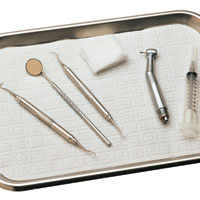Read Finding a Dentist Who Treats People With Bleeding Disorders.
Making dental care part of your family’s daily routine takes only a few minutes. Add a couple of annual dentist visits to your brushing and flossing regimen, and your preventive care can pay off in the long haul.
Unfortunately, insurance woes that range from having a complicated dental policy to one that doesn’t cover all procedures—or having no insurance—can make it tempting to skip those twice-a-year dental checkups.
Hemophilia and other bleeding disorders don’t make you more prone to dental problems. However, avoiding proper preventive care of your teeth and gums can lead to more complicated and costly procedures in the future. Children and adults with hemophilia and other bleeding disorders need an aggressive, prevention-oriented program to maintain optimal oral health and minimize the risk of complications if dental problems arise.
Certain procedures, such as tooth extractions or other oral surgeries, should start with a consultation with your hemophilia treatment center (HTC) or hematologist and your dentist to determine what precautions need to be taken before a dental visit.
Planning ahead on both the provider and payment fronts can be beneficial on the home front, too. Finding a dental home—a dental care team you are comfortable with—is perhaps the most important place to start. Investigating options for how to pay for that care is also critical.
“You have to have a dental home and be seen on a regular basis to prevent problems from developing,” says Richard Burke, DMD, director of the division of pediatric dentistry at the University of Iowa Hospitals and Clinics in Iowa City.
You also need to do your part. A preventive dental program is effective in averting most dental problems, Burke says. Such a program should include daily teeth cleaning with a toothbrush and toothpaste, flossing, appropriate topical fluoride use, a proper diet and professional examinations at regular intervals.
Contrary to popular belief, children and adults with bleeding disorders can and should floss daily. If people are not flossing regularly, their gums are more likely to bleed when they start because of a condition called marginal gingivitis, explains Gayle Gilbaugh, RDH, a dental hygienist who works with Burke. Gingivitis is a type of gum disease that develops when bacteria build up between your teeth and gums, leading to irritation, inflammation and bleeding.
“As the bacteria are removed on a daily basis, the gum tissue will get healthier and the bleeding will lessen,” Gilbaugh says. “I usually tell folks with a bleeding disorder that their gums may always bleed a little easier than someone without a bleeding disorder, but the goal is to keep the gingival tissue as healthy as possible.”
Flossing should begin as soon as a child has two teeth that touch each other, says Melissa A. Kennell, DDS, a general dentist in Gilford, New Hampshire, who treats only children. Kennell’s son, Preston, 3 ½, has severe hemophilia A. Kennell flosses and brushes his teeth every morning and evening. “It’s important to get flossing into the child’s routine,” she says.
Prevention Starts With the First Tooth
The American Academy of Pediatric Dentistry (AAPD) recommends that parents or caregivers establish a dental home for an infant by the time the child is 12 months old. At a child’s first visit, the dentist will likely offer what Burke calls “anticipatory guidance” to the parents or caregivers. “It’s teaching parents tools they never would have thought of, like flossing at a young age,” Kennell says.
In addition, the dentist will advise the parents on the proper amount of fluoride. “Fluoride is a wonderful thing, but too much fluoride can cause enamel fluorosis, where adult teeth can come out chalky white or brown or have little white spots,” Kennell says. A child can get too much fluoride if, for example, he is given fluoride supplements because he lives in a community without fluoridated water, yet goes to a day care in a town with fluoridated water. Young children should not be given fluoridated toothpaste until they know how to rinse and spit without swallowing it.
 The dentist will also discuss mouth and teeth injury prevention and dietary issues. This includes the use of bottles and “sippy” cups, which can cause tooth decay and cavities, sometimes referred to as “baby bottle syndrome.” Experts agree that a baby’s bottle should contain nothing but milk or water. The child should not be sent to bed with a bottle or sippy cup, nor breastfed to sleep, if the child has teeth, Kennell says. The sugary liquids pool around the teeth while the child sleeps. Then bacteria in the mouth use the sugar as food, producing acid that attacks the teeth.
The dentist will also discuss mouth and teeth injury prevention and dietary issues. This includes the use of bottles and “sippy” cups, which can cause tooth decay and cavities, sometimes referred to as “baby bottle syndrome.” Experts agree that a baby’s bottle should contain nothing but milk or water. The child should not be sent to bed with a bottle or sippy cup, nor breastfed to sleep, if the child has teeth, Kennell says. The sugary liquids pool around the teeth while the child sleeps. Then bacteria in the mouth use the sugar as food, producing acid that attacks the teeth.
Most baby teeth emerge without difficulty, typically between ages 6 to 10 months. Don’t worry if your child’s first tooth doesn’t come in until 12 months, says Kennell. Liquid Amicar® is often prescribed for bleeding in teething children who have a bleeding disorder. Your HTC may even give you a prescription ahead of time so you have it at home if you need it, Kennell says. Amicar has an expiration date, so check the label before using.
Losing Baby Teeth
For most children with a bleeding disorder, “exfoliation,” or the loss of baby teeth, is not a problem. Experts say teeth should be allowed to fall out naturally—not be pulled—to minimize bleeding. Bleeding can usually be controlled with direct finger-and-gauze pressure maintained for several minutes, Burke says. Parents should wash their hands, then wrap a small piece of sterile gauze around their index finger and apply pressure to the area that is bleeding.
A moist, black tea bag can also help because the tannic acid in dark tea helps form blood clots. Place a wet, black tea bag over the area and apply pressure or have the child bite down gently on the tea bag.
The direct topical application of hemostatic agents—chemicals that stop bleeding, such as Amicar—may also help. After a tooth falls out, give children cool, soft foods, but avoid hot foods and straws. “Don’t let children rinse or swish anything around in their mouth, because that can disrupt the blood clots that are forming,” Kennell says.
If bleeding is persistent, contact your HTC. It is rare for routine exfoliation to cause severe bleeding and hospitalization, says dental hygienist Karen Ridley, RDH, MS, assistant professor of dental hygiene at the University of Michigan in Ann Arbor. She has worked closely with HTCs for many years. But if severe bleeding occurs, the dentist might recommend a serial extraction next time, such as taking out all four molars when they are loose.
The Factor Aspect
Whether you will need extra factor product coverage for a dental procedure will be determined by your hematologist. It is based on the severity of your disease, your history and the procedure itself, such as an extraction vs. a deep scaling. Deep scaling is a thorough cleaning to stop gum disease from progressing. It is usually performed after the bacteria and inflammation from untreated gingivitis have worked their way down to the foundations of the tooth. For such procedures, factor replacement therapy may be considered, Burke says.
 Burke recommends that patients with a bleeding disorder and periodontal disease be placed on a maintenance schedule to avoid further progression. He may ask patients to return every three, four or six months, depending on the severity of the condition.
Burke recommends that patients with a bleeding disorder and periodontal disease be placed on a maintenance schedule to avoid further progression. He may ask patients to return every three, four or six months, depending on the severity of the condition.
People with inhibitors usually require treatment in a hospital setting. Patients with HIV, central venous access devices or who have had joint replacement surgery may need prophylactic antibiotic therapy before undergoing any dental procedures. People with rare bleeding disorders and von Willebrand disease should also consult with their HTC and dentist to discuss their specific needs before any procedures.
Factor is not the only solution for dental-related bleeding. According to Burke, hemostatic agents such as Amicar, Avitene®, Gelfoam®, Stimate Nasal Spray® and Surgicel® can be used to help stop local bleeding. Burke says some dentists are also using Lysteda®, a tablet form of tranxemic acid that was approved by the US Food and Drug Administration in 2009 to treat heavy menstrual bleeding. Tranxemic acid has long been used in the US as an injection to prevent bleeding from tooth extraction.
The high costs of factor may necessitate doing several procedures at once to save money and maximize efficiency, Burke says. When someone has multiple problems on different sides of the mouth, it often makes sense to infuse first, anticipating a lengthier stay in the dentist’s chair. Some patients may also need to infuse afterward. “We try to get all the treatment done in one visit if possible,” Burke says. This may include the use of nitrous oxide (also known as “laughing gas”), sedation and close coordination with the patient’s hematologist.
The social worker or financial reimbursement specialist at your HTC may be able to help you plan for the added costs of extra factor needed for dental procedures.
Insurance Concerns
Nick Reiser, 24, has severe hemophilia A and is one of those rare people who had significant bleeding when he lost his baby teeth.
“It was definitely a big hassle for my parents,” says Reiser, of Howell, New Jersey. He alerted his parents to another lost tooth at age 8 by walking into the room and saying, “Hi, I’ve got a pile of blood in my hands, and it’s not stopping.” He adds, “So I had trips to the emergency room instead of visits from the tooth fairy.”
After switching dentists, Reiser eventually found what he considered his dental home, with a pediatric dentist who understood his hemophilia. When he hit his 20s, however, he had trouble finding another dentist. Insurance also dictated his dental health.
My health insurance changed, and I didn’t have dental care for a while,” Reiser says. He thought, “Do I spend my last dollars going to the HTC to get my checkup or pay out the nose without insurance?”
Insurance coverage varies from state to state. Some dental patients with a bleeding disorder depend on Medicaid or some form of subsidized dental care, but some state Medicaid programs do not include dental coverage. And in those that do, there may be few providers that accept Medicaid. In Michigan, the state has a large network of federally funded community dental clinics and receives funding to provide some dental care through HTCs, according to Ridley.
Most HTCs and chapters have a referral list of resources in your area. Though rare, some hospital-based dental programs treat patients who have multiple health complications. In addition, some dental clinics have sliding-fee scales based on income. Some chapters, including the Northern Ohio, Indiana, Greater Florida and Georgia chapters, have dental care programs.
Reiser now has dental insurance through his job at an electronics assembly plant, but he hasn’t found a new dentist who will treat someone with hemophilia. “I haven’t had any dental issues,” he says, but he also hasn’t seen a dentist in about five years.
Innovative Solutions
A few years ago, leaders at Hemophilia of Indiana, a chapter of the National Hemophilia Foundation, and the Indiana Hemophilia & Thrombosis Center in Indianapolis started considering how they could provide dental care assistance for their bleeding disorders community. By offering financial options to help people maintain their dental health, they hoped to encourage them to see their dentist more regularly. They anticipated that this, in turn, would help avoid some of the problems and complications of coordinating care for more serious dental work.
Delta Dental, the largest dental health insurer in the state, accepted a proposal to start a group plan for members of the Indiana chapter and their families. The first member was enrolled on September 1, 2006; the group now includes 108 policies with 280 individual enrollees. Almost none of them had dental insurance before the launch of this program. “It’s a program we believe very strongly in and will continue,” says Scott Ehnes, the chapter’s executive director.
The two dental hygienists who work at the HTC act as case managers for Delta Dental. They understand the plan and advise enrollees about how to get the most value out of their benefits, based on what care is needed.
Other chapters or HTCs interested in starting a similar program should review their state’s laws for forming a group for insurance purposes. They can identify the larger dental providers in their region, who would likely be more willing to work with the groups and have the best prices.
Establishing and maintaining a connection with a dental team provides peace of mind, Burke says. After all, you can’t predict when you’re going to need dental intervention. When you do, it’s comforting to have a dentist who knows you and understands your needs.
“The concept of that dental home is so important,” Burke says. “Emergencies never happen 9 to 5.”


 To increase preventive dental care in the community and to promote and train patients to self-infuse, the HTC applied for a grant from the Centers for Disease Control and Prevention’s (CDC’s)
To increase preventive dental care in the community and to promote and train patients to self-infuse, the HTC applied for a grant from the Centers for Disease Control and Prevention’s (CDC’s)